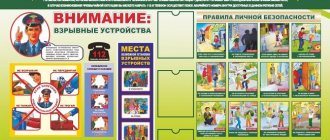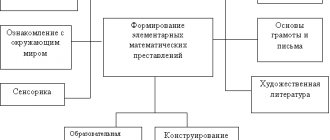Report: Systematic activity approach in educational activities with preschoolers"
Municipal preschool educational institution
"Nursery-garden No. 352 of the city of Donetsk"
D O C L A D
Topic: “System-activity approach in educational activities with preschoolers”
Installation teachers' council
from 2.09.2016
Prepared the report
Category I teacher
Yurchenko T.V.
Activity approach in educational activities with preschoolers.
The world around us has changed, and so have the children. The main task of their upbringing is to understand the detailed development plan of the child, which he already has.
The preschool education system has moved to a new stage: evidence of this is the emergence of a fundamentally new document - the State Educational Standard for Preschool Education (GOS do).
The task of preschool education is not to maximize the acceleration of the child’s development, not to formulate the timing and pace of transferring him to the “rails” of school age, but, first of all, to create for each preschooler all the conditions for the fullest disclosure and realization of his unique, age-specific potential . Today, the acute problem is how to expand the education system towards educating an individual capable of creatively solving life problems, which includes educating a creative person capable of creating universal human values: spiritual and cultural.
Nature allows a person very little time in childhood so that he can reveal his creative potential.
A modern kindergarten should become a place where a child gets the opportunity to have extensive emotional and practical independent contact with the areas of life that are closest and most significant for his development. Accumulation by a child, under the guidance of an adult, of valuable experience of knowledge, activity, creativity, comprehension of his capabilities, self-knowledge - this is the path that helps to reveal the age-related potential of a preschooler.
Updating the content of education requires the teacher to search for methods, techniques, pedagogical technologies that activate the activity and activity of the child, developing the child’s personality in the process of various types of activities. That is why the activity approach in organizing the educational process in preschool educational institutions is so in demand.
The system-activity approach is the organization of the educational process, in which the main place is given to the active and versatile, to the maximum extent, independent cognitive activity of the child. Its key point is the gradual departure from informational reproductive knowledge to knowledge of action. This approach to organizing the learning process, in which the problem of the child’s self-determination in the educational process comes to the fore.
The goal of the system-activity approach is to educate the child’s personality as a subject of life activity. In the most general sense, to be a subject means to be the master of one’s activities, one’s life.
The child learns to independently set goals, solve problems, and be responsible for results. The main means of the subject is the ability to learn, that is, to teach oneself. Such activities are a universal means of development.
The systemic-activity approach to learning presupposes that children have a cognitive motive (the desire to know, discover, learn) and a specific educational goal (an understanding of what exactly needs to be found out, mastered).
The role of the teacher in the implementation of the system-activity approach is great, since it is the teacher who is the key figure in the educational process. In the process of implementing the system-activity approach in education, the formation of a child’s personality and his advancement in development is carried out not when he perceives knowledge in a ready-made form, but in the process of his own activities aimed at “discovering new knowledge.”
The principle of activity distinguishes the child as an actor in the educational process, and the teacher is assigned the role of organizer and coordinator of this process. It is difficult to overestimate the role of the teacher’s activities, its influence on the process of formation and development of the child’s personality. Everything is important here: the rejection of the authoritarian style of communication in favor of a democratic one, and the personal qualities of the teacher, and his ability for self-development, and his professional competence.
System-activity approach as the basis of state educational standards.
Activity is an active attitude towards the surrounding reality, expressed in influencing it. It consists of actions.
Activity is a system of human actions aimed at achieving a specific goal. The activity approach is the organization and management by the teacher of the child’s activities when he solves specially organized educational tasks of varying complexity and issues. These tasks develop not only the child’s subject, communicative and other types of competencies, but also the child himself as a person (L.G. Peterson).
The activity approach is a way to master the educational environment without mental and physical overload of children, in which every child can self-realize and feel the joy of creativity.
The main idea of the systemic activity approach is associated not with the activity itself, but with activity as a means of formation and development of the child’s subjectivity. As a result of the use of forms, techniques and methods of educational work, what is born is not a robot, trained and programmed to clearly perform certain actions and activities, but a Human (with a capital “H”), capable of selecting, evaluating, programming and designing those types of activities which are adequate to his nature, satisfy his needs for self-development and self-realization.
An indispensable condition for the effectiveness of education in the context of the activity approach is reliance on the child’s own strengths, on the internal logic of his development.
This look at the mechanism of formation and formation of a child’s subjectivity allows us to see a systemic-activity approach to education as a personality-oriented approach.
Within the framework of the activity approach, the teacher faces the following tasks:
- create conditions to make the child’s process of acquiring knowledge motivated;
- teach the child to independently set a goal and find ways, including means, to achieve it;
- help the child develop the skills of control and self-control, assessment and self-esteem.
The activity approach is based on the position that a person’s psychological abilities are the result of the transformation of external objective activity into internal mental activity through successive changes.
The systemic activity approach determines a change in the general paradigm of education, which is reflected in the transition:
- from defining the goal of preschool education as the acquisition of knowledge, skills, abilities to defining the goal as the formation of the ability to learn, as a competency;
- from the “isolated” study by preschoolers of the system of scientific concepts that make up the content of the educational process, to the inclusion of the content of learning in the context of solving significant life problems (that is, from focusing on the educational and subject content of school subjects to understanding learning as a process of education and the generation of meanings);
- from the spontaneity of a child’s educational activity to its purposeful organization and systematic formation, the creation of individual educational trajectories;
- from an individual form of knowledge acquisition to recognition of the decisive role of educational cooperation in achieving educational goals.
The essence of education from the point of view of the activity approach is that the focus is not just on activity, but on the joint activity of children with adults in the implementation of jointly developed goals and objectives. The teacher does not provide ready-made samples, he creates and develops them together with the children, a joint search for the norms and laws of life in the process of activity and constitutes the content of the educational process, implemented in the context of the activity approach.
Methodological approaches to organizing classes with children:
- the child takes an active position in the lesson: he is now a listener, now an observer, now an actor;
- During educational activities, the spirit of discovery prevails;
- change of scenery and movement are required;
- the next type of activity should begin with the formulation of the problem in general form;
- do not accept children’s answers without justifying their opinion and do not leave a single answer unattended;
- abandon the judicial role: when a child speaks, he addresses the children, and not the teacher;
- teach children to see the possibility of versatility in completing tasks;
- the child’s statistical pose should not exceed 50% of the time of the entire lesson;
- in the process of managing children's activities, only a democratic style of communication is acceptable;
- It is necessary to maintain a sense of success in children.
| Stages of activity | Content |
| Process of involvement in activities:
|
| Putting forward various options for what to do to resolve the problem. Do not evaluate children’s answers, accept any, do not offer to do or not do something, but offer to do something to choose from. Rely on children's personal experience when choosing assistants or consultants. During the activity, the teacher always asks the children: “Why, why are you doing this?” so that the child comprehends every step. If a child does something wrong, give him the opportunity to understand what exactly, you can send a smarter child to help |
| Don’t ask your children whether they liked it or not. You need to ask: “Why did you do this?” to understand whether the child realized the goal |
| Find who to praise for what (not only for the result, but also for the activity in the process) |
Methods and forms used in the activity approach:
dialogue, project, game motivation, goal setting, creating a situation of choice, reflective pedagogical support, creating a situation of success, ensuring self-realization of children.
Forms of self-realization of preschool children.
Exhibitions (thematic, author's).
Personal exhibitions of children's robots.
Presentations.
Game projects (a prerequisite for a child’s self-realization is his participation in the project and the product of children’s activities).
Collections.
Golden rules of the activity approach.
- Give your child the joy of creativity and awareness of the author's voice.
- Lead your child from personal experience to public experience.
- Be not “above”, but “next to”.
- Be happy about the question, but don’t rush to answer.
- Learn to analyze each stage of work.
- By criticizing, stimulate the child’s activity.
The significance of changes in the system of additional education
The basis of the Federal State Educational Standard is a systematic, activity-based approach to each child, developing in the younger generation the ability to solve complex problems and tasks. Modern society puts forward serious demands on the process of additional education. Russia needs moral, educated, enterprising young people who are able to predict the results of their actions, who are ready to feel pride and responsibility for their family and country.
Since the priority of the educational system and society is the preparation of young people entering a new life, the result of training is characterized by their successful adaptation in society.
The system-activity approach as the basis of the Federal State Educational Standard is aimed at creating optimal conditions for self-realization of the younger generation of post-industrial society. A teacher cannot “sculpt” or “make” a child with a passive version of teaching and upbringing. Only by involving schoolchildren in joint activities can the desired result be achieved and the social order be fulfilled in full.
Personality development
As a result of joint fruitful activities, children get the opportunity to realize their creative potential.
The system-activity approach is the basis for the effective implementation of the second generation Federal State Educational Standard. This method differs from traditional educational technologies in its variety of forms and the possibility of active inclusion in search and research activities.
How else do innovative educational technologies differ? The system-activity approach is the basis of the Federal State Educational Standard of LLC, without it it is difficult to fulfill the requirements that society places on the level of modern education.
The basis for the success of each child, the formation of his skills and numerous competencies, should be a systematic change of methods and types of activities, which is fully ensured by innovative educational technologies.
The system-activity approach as the technological basis of the Federal State Educational Standard needs an updated methodological base. It involves the selection of a set of innovative approaches and techniques that allow the teacher to enhance the students’ own activities.
Relevance of the method
Peterson created the system-activity approach. As the basis of the Federal State Educational Standard, he proposed the organization and control of educational and educational activities of preschool children in the context of life. A prerequisite is to take into account life plans, interests, values, and the use of innovative techniques and techniques.
The new preschool education paradigm has an activity-based version. Its main goal is the development of the personality of a preschooler on the basis of mastering universal methods of developing skills and abilities that form the instrumental basis of educational learning.
The system-activity approach is the basis of the Federal State Educational Standard of NEO. Its distinctive feature is the allocation of special attention to the process of development of the personality of a preschooler, his acquisition of moral, spiritual, and social experience.
It is this approach that has recently become the leading scientific method of cognition and transformation of objects. This direction of the methodology of theoretical research and social practice, based on the consideration of various subjects and objects as integral systems, makes it possible to identify the variability of educational subject areas.
Federal state requirements of the new generation require the allocation of a certain number of hours for the regional component in all academic disciplines. For example, as part of environmental education, children get acquainted with the trees, plants, and animals of their region, and gain experience in a tolerant attitude towards living nature.
The essence of the technique is to consider independent components in interconnection, movement, constant development and improvement.
This activity-based approach is the basis of the Federal State Educational Standards LLC, which are currently introduced into Russian preschool education.
A differentiated approach to education makes it possible to identify systemic integrative properties, as well as qualitative characteristics necessary for the harmonious development of the younger generation in Russia.
The historical, functional, substantive aspects of an integrated approach require a combination of such principles of analysis as specificity, historicism, taking into account development and comprehensive connections.
The cultural-historical aspect is based on the theoretical provisions of the pedagogical concepts of Galperin, Leontiev, Vygotsky. They paid special attention to the basic psychological laws of the processes of education and training, the structure of the educational activities of preschoolers, with mandatory consideration of the main features of the individual age development of children.
The main type of thinking that is associated with the new educational concept involves empirical thinking. The child gets the opportunity to select his own content of education, to choose in large quantities those areas that are interesting to children.
Specifics of the approach
The system-activity approach to teaching is the basis of the Federal State Educational Standard for preschool education. At the end of the last century, in domestic education attention was paid only to the acquisition of knowledge. No one attached importance to the issue related to the search for effective ways to assimilate theory, the development of individuality, the formation of citizenship and patriotism in the younger generation.
Training was based on the verbal method and forms of transmitting ready-made information, impersonality and monotony, and passive teaching of children. The information that they were forced to memorize was useless, schoolchildren did not need it in everyday life, and did not contribute to social adaptation and success in the profession.
Forms and methods
The system-activity approach as the basis for the implementation of the Federal State Educational Standard makes it possible to take into account the age-related, physiological, and psychological characteristics of children. Particular importance in the new educational system is given to the search for forms of communication between mentor and student for full and productive joint activities.
New technologies ensure a smooth transition from preschool education to the school level.
The system-activity approach as the basis for the implementation of the Federal State Educational Standard is distinguished by various organizational forms and allows taking into account the individual abilities of each individual student. Teachers can work not only with gifted children, but also with children with health limitations.
New educational trajectories
The system-activity approach as the basis of the Federal State Educational Standard involves assessing the quality of education according to certain criteria:
- learning results are personal and socially significant;
- high-quality knowledge allows children to build individual educational trajectories for personal development;
- differentiation of training is allowed while maintaining the unity of theoretical material;
- increased motivation of schoolchildren to study is manifested;
- conditions are created for personal and general cultural improvement;
- the formation of competencies is carried out in different subject areas.
The system-activity approach as the basis of the Federal State Educational Standard has practical significance; it is relevant and in demand in modern society.
History of formation
The idea of combining activity and systems approaches was proposed by domestic scientists and teachers. The system-activity approach as the methodological basis of the Federal State Educational Standard appeared in 1985. Among its developers, we highlight E.V. Ilyenkov, E.G. Yudin, and psychologist A.G. Asmolov. The developers of the new educational system carefully studied the experience of foreign colleagues, as well as the methods of developmental and advanced learning created by L. S. Vygotsky, L. V. Zankov, D. B. Elkonin.
The system-activity approach as the methodological basis of the Federal State Educational Standard was the result of a synthesis of various innovative technologies created in the 20th century by foreign and domestic psychologists and scientists. He included the best teaching experience of several decades. Today, the system-activity approach is the basis of domestic education at all levels, including the preschool system.
The educational process in preschool educational institutions is regulated by state standards developed for the preschool educational program.






